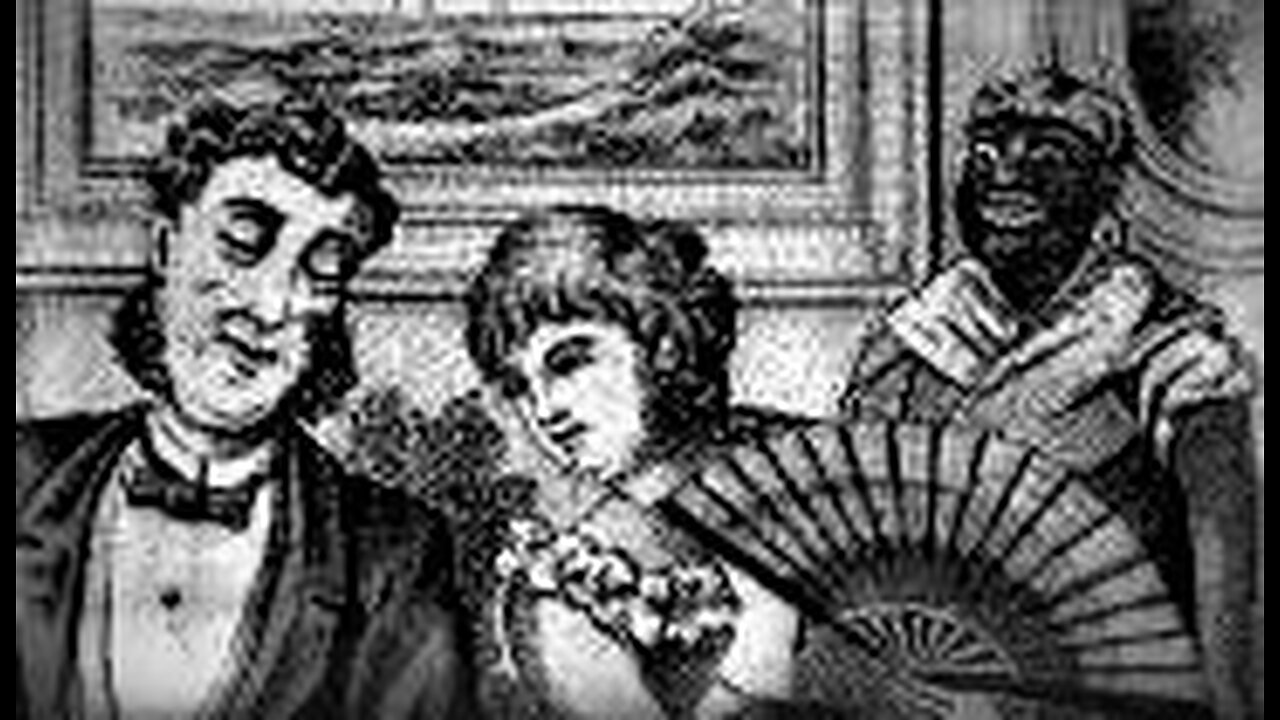Premium Only Content

Unexplained: 19th Century Images (marathon)
Illustrated advertising cards African stereotypes as foils in order to appeal to white consumers
After decades of presenting the archetypal American consumer as white and female, advertisers are slowly broadening their imagery to include more diversity.
But, as the scholar Marilyn Maness Mehaffy writes, the history of race in American advertisements isn’t just about the absence of non-white buyers.
She argues that the creation of the ideal white, female consumer in the expanding consumer economy of the late nineteenth century depended on the inclusion of women of other races, particularly African-Americans, as a foil.
Mehaffy focuses on illustrated advertising cards. In the late nineteenth century, consumer brands printed the colorful cards to spread awareness of their products. Both children and adults saved the cards, leading to a collector’s craze.
The domestic, white, female consumer is defined in relation to a complementary preindustrial black laborer.
Some cards simply depicted animals, flowers, or landscapes. But one archivist found up to forty percent of the cards in a typical museum collection invoked ethnic stereotypes. In particular, Mehaffy writes, a striking number of illustrated cards depicted a pair of women:
one white and one Black.
In one card advertising cotton thread, for example, a modestly dressed white woman sewing in her chair is juxtaposed with a black woman in short sleeves laboring in a cotton field.
The domestic, white, female consumer is defined in relation to a complementary preindustrial black laborer.
Similarly, Mehaffy notes, a number of the cards depicted a white women, sometimes with her children, at home beside a black servant. One, advertising the Redwood Portable Range, offers a striking contrast between a caricatured black domestic worker with bulging eyes and a statuesque white women in a gown. The servant is evidently an important part of the scene of domestic consumption, offering her employer advice about which stove to buy.
Other cards explicitly tie consumer products to white femininity. A card for Hunter’s Flour & Meal Sifters contrasts “the old way” of sifting flour—illustrated with a black woman laboring over a large sieve—and “the new way”—a white women effortlessly using the modern tool.
A fold-out card advertising the Eclipse Clothes Wringer shows two versions of a scene with a white woman supervising a Black domestic worker doing the wash.
In the first, the servant has her sleeves rolled up and is wringing the clothes out by hand. In the second, the black woman—now using the mechanical clothes wringer—is dressed more primly and is less muscular, with thinner lips and “whiter” features (thought the text still shows her speaking in a caricatured black dialect). The consumer product seems to imply that making the African-American woman more like her white counterpart is an “improvement.”
Mehaffy argues that the contrast between white and black women helped define the role of race in the post-Civil War era, as the country became increasingly industrialized.
Later, images of black people in consumer branding dwindled to a few prominent, and still problematic, characters like Aunt Jemima, leaving advertising a mostly white space through much of the twentieth century.
Imperialism, Revolution, and Industrialization in 19th-Century Europe
Industrialization takes hold in Western Europe
Imperialism, Revolution, and Industrialization in 19th Century Europe Explained
Throughout 19th-century Europe, political and economic forces helped to dramatically alter the European continent that forever changed the countries and people that inhabited them. In less than a century, the absolutist ideals of the Old Regime started to wither away as revolutionary ideals of freedom and democracy attempted to take hold across Europe.
Industrialization, with its powerful economic connections, greatly fueled these revolutions through the development of both social strife and inequality. Moreover, nationalist sentiment and imperialism directly contributed to these changes by promoting racism and competition between the powerful emerging nation-states. As this article seeks to demonstrate, however, revolution, industrialization, and imperialism did not always follow a consistent or steady pattern. Rather, they differed quite significantly depending upon the country and people involved during their progression.
As a result, Europeans experienced uneven and sporadic waves of change across the long nineteenth century. What accounts for these discrepancies? What factors contributed to the differences that each country experienced regarding revolution, industrialization, and imperialism during this era?
Revolution and Nationalism
Revolutions in Europe greatly varied from each country to the next. To understand how they affected nineteenth-century Europe, however, it is important to first define the term, “revolution.” Revolution is a term that conjures up many definitions. Generally speaking, it involves a fundamental shift or change within society that alters the social, political, or economic ideals of a country and its people.
Similarly, historian Norman Rich asserts that the term describes any “transformation” of society that takes place over “a long period of time” (Rich, 1). To be certain, Charles Breunig proclaims that this type of change does not always include a clear “break with the past” (Breunig, xi). Basic elements of the society often remain in the aftermath of revolutions.
The goals, ideals, and beliefs of the people, however, are often forever changed through the revolutionary process. This is precisely the situation that unraveled within Europe during the nineteenth-century and the aftermath of the Napoleonic Wars.
As Breunig asserts:
“many traditional institutions and ideas persisted through the revolutionary and Napoleonic eras into the age of the Restoration” (Breunig, xi).
While basic tenets of European society and culture remained intact, the liberal ideas unleashed by the French Revolution, nevertheless, served to greatly challenge the established monarchies and aristocracies of Europe.
In their aftermath, these challenges to authority set the stage for future governments more responsible to their people, rather than governments that relied solely on absolute rule.
Moreover, the revolutions of nineteenth-century Europe ushered in democratic virtues of liberty and equality that later evolved into the current models of governance in existence today. With this basic understanding of revolutions and their impact on nineteenth-century Europe, several important questions arise.
What accounted for these revolutionary uprisings?
Specifically, what factors led to their overall development and progression?
Why did differences in the experiences of revolution exist among the countries of Europe? More specifically, why did certain regions of Europe experience change more rapidly than other parts?
The revolutions across Europe directly resulted from the radical views of the French that first emerged during the French Revolution.
In an attempt to dismantle the ideas embraced by the Old Regime, French revolutionaries (inspired by the American Revolution only a few years prior) attacked the social and political ideals of their time in favor of measures that ostensibly favored universal equality and liberty for all.
With the rise of Napoleon Bonaparte and his conquests across Europe, these French ideas quickly spread to neighboring regions as country after country fell victim to Napoleon’s powerful army.
This aspect is important to consider, as it helps explain the inconsistencies between Eastern and Western Europe in regard to the revolutions each country experienced.
Western powers with a closer proximity to France, experienced revolution far sooner than the countries of Eastern Europe since their populations existed within the boundaries of French influence.
This influence was further enhanced once Napoleon gained control over Italy, the German states, and portions of Austria-Hungary through his conquests. As part of his rule, Napoleon implemented tremendous changes within these countries, both economically and politically.
The Napoleonic Codes, according to Breunig, destroyed the prior political establishments of these countries, and in their place, implemented policies that mimicked “French institutions” (Breunig, 93).
Because the imperial structure set up by Napoleon destroyed the social and political elements of the Old Regime across Western Europe, Napoleon set the stage for future revolutionary developments within these countries that progressed more rapidly than in places such as Russia.
Napoleon’s conquests also spread ideas of nationalism that emerged from the French Revolution. Nationalism, which reflected ideas of extreme patriotism and pride, played a tremendous role in developing the revolutionary changes that occurred across Europe.
Nationalism provided individuals with an identity, and a connection with people of similar cultural and linguistic backgrounds. By conquering the countries and states surrounding France, Breunig proclaims that Napoleon, inadvertently, “contributed to a greater sense of unity” among those he conquered, particularly within the Italian and German states (Breunig, 94).
Through his harsh and dictatorial rule, Napoleon aroused “patriotic resentment among the peoples subjected to French domination” (Breunig, 95). This is important to consider, since these sentiments did not vanish over time.
Even decades after the fall of Napoleon and the French Empire, Breunig asserts that “the seeds sown during the Napoleonic era bore fruit in the nationalist movements of the nineteenth century” (Breunig, 95).
This case is greatly illustrated by the German states during the middle years of the nineteenth-century. Although Germany did not form into a collective nation-state until the time of Bismarck, Breunig proclaims that discontent in the 1840s helped invigorate the patriotic seeds first sown by Napoleon into “a wave of popular discontent” across the German states, particularly within Prussia (Breunig, 238).
For these reasons, Western Europe experienced upheavals of their political and social systems far sooner than the countries of the East.
These disruptions and encouragement of nationalist sentiment, consequently, aided in the development of revolutionary thoughts long before such ideas emerged in the East. Distance, in this sense, greatly explains the revolutionary incongruities that existed throughout Europe during the nineteenth-century. Eastern countries remained far removed from the dissent fomenting in the West.
Moreover, distance gave the Eastern rulers ample time to implement measures capable of stifling and muting future dissenters, thus, preventing revolutionary reactions within their own countries.
According to Marc Raeff, Tsar Nicholas I of Russia, “worked hard to prevent Western liberal ideas from gaining a foothold with the educated public” (Raeff, 148).
As he states:
“censorship was extremely severe: anything suspicious or capable of being interpreted as adverse criticism of the existing state of affairs was proscribed” (Raeff, 148). Not surprisingly, such tactics and actions helped to greatly delay radical Western ideas from permeating the Russian empire.
Nevertheless, Western elements of revolution and nationalism did eventually infiltrate the East during Napoleon’s invasion of the Russian Empire. Similar to his conquests in the West, Napoleon inadvertently introduced concepts of the French Revolution to the vast forces he encountered. Therefore, understanding Napoleon’s impact is important because it helps to explain multiple aspects about revolutions in Europe.
Not only does it demonstrate why an unevenness of revolutions existed within Europe, but it also explains the root causes of nationalism and why nationalist sentiment spread beyond the French boundaries to impact European societies at large.
The revolutionary and nationalist sentiments introduced by Napoleon, in turn, aided in the disruption of the balance of power across Europe, and directly resulted in the tense military and political atmosphere that emerged following the Congress of Vienna in 1815.
Political and institutional changes, however, are not the only revolutions that took place across Europe. Industrialization, to a large degree, brought economic change to Europe on a scale never before seen. Just as the political revolutions of Europe varied from country to country, so too did the forces of industrialization that favored particular social, economic, and political environments over others.
Industrialization
According to Charles Breunig, the Industrial Revolution “transformed the lives of Europeans even more thoroughly than did the French Revolution” (Breunig, xii). But what factors contributed to its impact? According to Norman Rich, advancements in agriculture served as a major contributor to industrialization since it resulted in “greater availability of food in Europe,” and aided in the growth of population across the continent (Rich, 15).
This growth in population was important since it assisted in the development of cities and provided a consumer market to meet the large-scale production capabilities of industry. Revolutions in transportation and technology, such as the railroad and steamboat, further aided the development of industrialization since they provided a means for consumer goods to be shipped in mass quantities quickly and cost-effectively, across long distances.
As Rich states:
“the railroads made possible…the large-scale, economical, and rapid distribution of goods overland, they penetrated the remote interiors of countries and continents and opened up the markets of these regions to industry while giving agricultural regions access to urban markets” (Rich, 9).
Similar to the political revolutions taking place across Europe, industrialization varied greatly across the European continent. In Great Britain, for instance, the effects of industrialization were, perhaps, most recognizable since the British Empire fostered an atmosphere conducive to industry and its effects.
With an empire that stretched the globe, Britain possessed a large and diverse population, as well as a vast consumer market that helped stimulate the production of mass quantities of goods. Furthermore, Charles Breunig asserts that part of the intensity with Britain’s industrialization lies with the fact that its empire possessed large quantities of “raw materials,” a large quantity of “capital for investment,” and “surplus labor” sources that did not exist on this scale within the rest of the European continent (Breunig, 198-199).
According to historian, Anna Clark, however, the Industrial Revolution also created as many problems as it solved in Great Britain. This is particularly true if the social impact of the revolution is taken into account.
While the Industrial Revolution provided many individuals with jobs and an abundance of goods, Clark asserts that it also served to create social strife and gender inequality, and greatly expanded the divide between social classes (Clark, 269-270).
As she states:
“the social changes of industrialization drove up illegitimacy rates between the mid-eighteenth and the mid-nineteenth century, and wife desertion and bigamy seemed all to frequent” (Clark, 6).
Moreover, while Clark asserts that the “new opportunities” created by the Industrial Revolution “lessened poverty,” they also “increased divisions between men and women, as men worked in heavy industry and women either found jobs in the declining textile industry or stayed at home” (Clark, 270). Problems such as these greatly helped fuel the social and political revolutions taking place across Britain, and eventually Europe, at large.
Consequently, the social strife created by industry resulted in many of the problems seen in the last half of the nineteenth-century, particularly within Russia and the eventual Soviet Union.
Industrialization within France and Austria also provided similar effects, although not nearly as pronounced as the British example. According to Breunig, industrialization greatly aided in the modernization efforts within France.
However, as he states, their “persistence of a system of small landholding” greatly “handicapped the development of industry” when compared with Great Britain (Breunig, 199).
In regard to Austria, Norman Rich explains: “the industrial revolution brought to Austria the usual problems of city growth…but it also brought wealth and prosperity to a large section of the population and created a new middle class” (Rich, 106).
Like the other continental countries, however, Austria faced material shortages and a smaller-scale consumer market that paled in comparison to Great Britain.
Eastern Europe and Russia, in particular, did not experience the full effects of industrialization like Great Britain, France, and Austria until later into the nineteenth-century.
With its isolated position in Europe, Russia once again possessed a natural barrier to many of the changes sweeping across the continent.
Many of the institutions and policies of Russian governance continued to reflect the absolutist ideals espoused by the Old Regime, even into the twentieth-century. Serfdom, which amounted to basic elements of slavery, continued unabated until the 1860s in Russia.
As a result of this dependence on agriculture and the labor of serfs, Russia did not begin its modernization and industrialization policies until the late nineteenth-century (well after the industrial revolutions of Western Europe).
Fearful of encroachment and destruction by the hands of the Western powers, Russia sought to catch up to the industrialized and technologically advanced West only because its national interests were at stake.
With the unification and militarization of Germany during the 1860s and 1870s, such fears do not appear erroneous, especially when the aggressiveness of German military policies are taken into account.
The failure of Russia to industrialize later, rather than sooner, created many problems for the Russian Empire as it attempted to transition too quickly from an agricultural-based society to industry.
By diverting their attention away from agriculture too rapidly, the Russian Empire experienced social strife and economic problems that eventually led to its downfall, following World War I.
As seen, industrialization varied greatly between the powers of Europe since it required multiple factors for its success.
Nevertheless, its effects greatly impacted the European continent in a profound manner through the tremendous innovations it inspired in both technology and production. As a result, Europe advanced faster and more quickly than at any other time period in its history.
More importantly, however, industrialization helped cultivate and contribute to the rising social and political strife originally inspired by the French Revolution. Through its creation of imbalances in social class, gender, and wealth, industrialization helped set the stage for many of the social problems that existed in the latter part of the nineteenth-century that continued well into the twentieth-century as well.
Imperialism
Similar to the political, social, and industrial revolutions, discrepancies in the policies of imperialism varied across Europe as well. Ostensibly, imperialism expanded and grew as a result of the European desire to spread Christianity to the so-called heathen societies of the world, and as a means to bring civilization to the undeveloped tribes and clans of the globe.
As Mark Cocker asserts: Europeans believed “Christian civilization was the obvious apex and terminal point to which all mankind must inexorably aspire” (Cocker, 14). More often than not, however, imperial sentiments derived from a deeply racist view of indigenous people whom the Europeans viewed as inferior to their culture and way of life.
Because native traditions and practices did not reflect Christian elements of Europe, Cocker asserts that Europeans often viewed tribal societies as “subhuman” animals that lived outside “the margins of civilization” (Cocker, 13).
Imperialism also derived from a desire to acquire greater resources and raw materials for the various European economies.
In this essence, imperialism emerged, in some aspects, as a direct result of the industrial revolutions taking place across Europe during the nineteenth-century. Elements of nationalism also served to fortify imperialism, and greatly inspired the desires for global colonization.
Nationalism, with its ideas of patriotism and ethnic superiority, contributed to imperial ideas since it inspired competition among Europeans who desired greater national glory and pride.
The spirit of nationalism and imperialism, combined, prompted Europeans to expand their influence and territory through the domination of foreign lands and people. By scrambling to the far corners of the world to establish colonies, such ambitions aided in the construction of vast empires meant to compete with and overshadow rival European countries.
The creation of these empires resulted in immense competition and conflict between the Europeans that directly contributed to the intricate alliance systems of the late nineteenth-century, and the eventual outbreak of World War I in 1914.
Because of these competitive aspects, historian Isabel Hull states, “imperialism was war” (Hull, 332).
Not surprisingly, the ambitions for colonies and empires were not well founded, as the colonies cost far more to maintain than their actual worth. The brutal subjugation of foreign subjects further exacerbated these problems since these policies were often met with fierce resistance from locals who aimed to disrupt and harass the conquering European powers.
As a result of these problems, Europeans approached the issues of colonization in many of the same ways. Large-scale exterminations, mass-reprisals, and brutality all figured into the European methods of dealing with unruly natives. Nevertheless, some countries implemented more extreme measures than others for the sake of showing their military might and demonstrating their power to effectively control their subjects.
As Hull states, part of the prestige in possessing an empire is the ability to maintain order and discipline. When rebellions by natives succeeded, however, it “exposed the weaknesses of the colonizers” to their European rivals (Hull, 332). This element of imperialism is important to understand, as it helps to explain the different ways that European countries explored and experienced colonization in the nineteenth-century.
While a large portion of the European powers scrambled to take possession of colonies across the world, both Great Britain and France took control of the most colonies due to their economic and military strengths (Cocker, 284). Great Britain, with its tremendous naval power and global empire, was perhaps best suited for imperial endeavors, as it possessed the financial and military means to subjugate large foreign populations with relative ease.
Countries such as Belgium, Italy, and Germany, however, all experienced imperialism on a far different and smaller scale as they each struggled greatly to maintain security over their lesser territories. Because of this reason, smaller countries like Germany, which unified under Bismarck in the 1860s and 1870s, were forced to counter these setbacks through the implementation of brutal and often extreme tactics over their colonial subjects.
These tactics, largely similar to the British treatment of Aborigines in Tasmania and Australia, helped Germany maintain its status as a world power at the expense of the native Herero people of Southwest Africa.
The German example is particularly interesting since their imperial ambitions involved a level of aggressiveness not easily matched by the other European countries. More importantly, however, the German example also provides an excellent illustration of the differences, and long-term effects that imperialism had on Europe. Of particular interest is the point made by Isabel Hull regarding future conflicts in Europe.
Hull makes the point that German aggression in Southwest Africa directly resulted from its extreme military culture that pervaded all elements of its society. With no social and political oversight, the German military, essentially, acted without any real constraints on its power (Hull, 332). Thus, as a result of their success with colonization during the nineteenth-century, Hull asserts that the military extremism developed from imperialism helped inspire German aggression for World War I only a few decades later (Hull, 237).
Such ambitions, in turn, led to Germany’s ultimate destruction in the waning moments of the First World War. These ambitions are not strictly limited to Germany either. In one form or another, imperialism directly influenced future warfare and aggression of the other European powers as well, and contributed greatly to the tumultuous and conflict-driven twentieth-century.
Conclusion
In conclusion, the revolutions of the nineteenth-century dramatically transformed Europe’s social, political, and economic spectrums in a profound manner. While they certainly varied across the continent in their intensity and overall impact, all of Europe eventually succumbed to forces that destroyed the ideals of the Old Regime. As a result of the changes in politics and economics, the revolutions of the nineteenth-century set the stage for the conflict-filled twentieth-century, as nationalist sentiment inspired European countries to come to terms with their national aspirations and desire to establish vast empires. The changes wrought by these revolutions, therefore, truly resulted in the fundamental transformation of Europe.
Further Reading
Review: Charles Breunig's The Age of Revolution and Reaction, 1789-1850 (New York: W.W. Norton & Company, 1970).
Review: Anna Clark's The Struggle for the Breeches: Gender and the Making of the British Working Class (Los Angeles: University of California Press, 1995).
Review: Mark Cocker's Rivers of Blood, Rivers of Gold: Europe’s Conquest of Indigenous Peoples (New York: Grove Press, 1998).
Review: Marc Raeff's Understanding Imperial Russia: State and Society in the Old Regime (New York: Columbia University Press, 1984).
Works Cited:
Books / Articles:
Breunig, Charles. The Age of Revolution and Reaction, 1789-1850 (New York: W.W. Norton & Company, 1970).
Clark, Anna. The Struggle for the Breeches: Gender and the Making of the British Working Class (Los Angeles: University of California Press, 1995).
Cocker, Mark. Rivers of Blood, Rivers of Gold: Europe’s Conquest of Indigenous Peoples (New York: Grove Press, 1998).
Hull, Isabel. Absolute Destruction: Military Culture and the Practices of War in Imperial Germany (London: Cornell University Press, 2005).
Raeff, Marc. Understanding Imperial Russia: State and Society in the Old Regime (New York: Columbia University Press, 1984).
Rich, Norman. The Age of Nationalism and Reform, 1850-1890 (New York: W.W. Norton & Company, 1977).
Images / Photographs:
A brief summary of industrialization in France during the nineteenth century. Accessed August 02, 2017. https://www.mtholyoke.edu/courses/rschwart/hist255/la/industrialization.html.
"British Empire." Jama Masjid, Delhi - New World Encyclopedia. Accessed June 05, 2018. http://www.newworldencyclopedia.org/entry/British_Empire.
"History of Europe." Encyclopædia Britannica. Accessed August 02, 2017. https://www.britannica.com/topic/history-of-Europe.
History.com Staff. "Napoleon Bonaparte." History.com. 2009. Accessed August 02, 2017. http://www.history.com/topics/napoleon.
Wikipedia contributors, "Industrial Revolution," Wikipedia, The Free Encyclopedia, https://en.wikipedia.org/w/index.php?title=Industrial_Revolution&oldid=843485379 (accessed June 5, 2018).
This content is accurate and true to the best of the author’s knowledge and is not meant to substitute for formal and individualized advice from a qualified professional.
© 2017 Larry Slawson
Comments
Larry Slawson (author) from North Carolina on August 02, 2019:
I agree Denise! Its hard to say. But I think industrialization certainly aided with the revolutionary process if you look at the social issues it created across Europe.
Denise McGill from Fresno CA on August 01, 2019:
It is such a lot to take in. So many things precipitated other things, cause and effect. Do you think without industrialization there would have been no revolution?
Denise
aadesh tikhe on February 26, 2019:
when the information was published
sulaiman_bashir on May 01, 2018:
@Eric D, it's ansurb to think on a platform like this that revoultion means just a change as you have comceived in your comments. Revolution is multifaceted and multidimensional in its scope. It may cometh slow or rather sudden and spontaneous defending on the scale and circumstances prevailing at the material time. So, broaden your mind to not just the words used to describe a process or situation but also have a regard as to the context in which they are used. Thank you.
Eric Dierker from Spring Valley, CA. U.S.A. on August 03, 2017:
Semantics are terribly hard in philosophical and historical discussion. I just cannot cotton taking "revolution" out of the minds of the plenty and defining it as a "change in direction" even though it fits a construct to put forward a political/historical base. That is very much ivory tower thinking. Carter to Reagan was not a revolution. It was a change.
10o,000 bodies is a revolution. And yet of course our earth turns at so many revolutions per minute.
Once your premise is wrong your thesis becomes faulty. Change does not equal revolution.
https://www.historyextra.com/period/victorian/inside-19th-century-slums-new-york/
-
 30:09
30:09
Iggy Azalea
13 hours ago $7.17 earnedplaying motherland
74.2K38 -
 8:00:03
8:00:03
SpartakusLIVE
10 hours agoDuos w/ Rallied || A Spartan and a Dragon ENTERTAIN the MASSES
65.9K3 -
 20:09
20:09
Exploring With Nug
18 hours ago $2.95 earnedVanished After Driving Away… I Spent the Day Searching Lakes
67.6K5 -
 1:14:13
1:14:13
Glenn Greenwald
10 hours agoLee Fang and Leighton Woodhouse Look Back on Trump’s First 100 Days; Lara Friedman on New Laws Barring Israel Criticism | SYSTEM UPDATE #446
133K65 -
 9:01:19
9:01:19
ZWOGs
15 hours ago🔴LIVE IN 1440p! - DEATH STRANDING 1 - PLAYTHROUGH | DAY 4 | - Come Hang Out!
39.9K9 -
 1:45:28
1:45:28
Joker Effect
7 hours agoWhy aren't you trying to enjoy yourself? Live a little! go.mother.land/Joker
31.9K2 -
 2:06:37
2:06:37
Geeks + Gamers
7 hours agoMARIO KART WARS
24.2K -
 1:14:12
1:14:12
Right Side Broadcasting Network
5 days agoLIVE: Exclusive White House Special: President Trump's First 100 Days - 4/30/25
79.4K19 -
 1:02:30
1:02:30
BonginoReport
12 hours agoFBI Demotes Woke Agents Who Kneeled for George Floyd (Ep. 38) - Nightly Scroll with Hayley
130K144 -
 2:08:04
2:08:04
Tucker Carlson
10 hours agoMatt Walsh: Any country that can’t function without American aid has no right to exist.
132K281